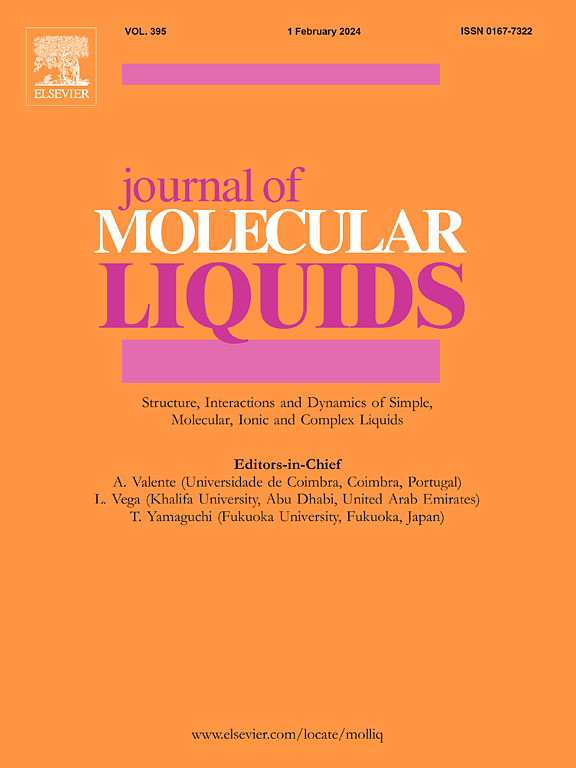逐步水化:debye - h ckel远距离相互作用和离子配对的比较
IF 5.3
2区 化学
Q2 CHEMISTRY, PHYSICAL
引用次数: 0
摘要
采用双组分模型对具有代表性的高溶性1-1 (NaCl和NaOH)、2-2 (MnSO4和UO2SO4)和3-1 (AlCl3)盐的溶液活度进行了模拟。一种与德拜-赫本文章由计算机程序翻译,如有差异,请以英文原文为准。
Step-wise Hydration: Comparison of Debye-Hückel Long-Range interactions and ion pairing
The concentration-based solution activity of representative highly soluble 1–1 (NaCl and NaOH), 2–2 (MnSO4 and UO2SO4), and 3–1 (AlCl3) salts were modeled with a two-component model. A step-wise hydration component combined with either Debye-Hückel (DH) or ion pairing (IP) component. Step-wise hydration competent models positive deviation from ideality of electrolytes on solution activity (higher activity coefficients or greater effective concentration than the Raoult’s ideal). DH and IP components, both model negative deviations from ideality (lower activity coefficients or less effective concentration than the Raoult’s ideal). Step-wise hydration with either DH or IP can model both solution activity and molal osmotic coefficients, respectively emphasizing the fitting of higher concentration data or lower concentration data. Both the DH and IP based models performed similarly from dilute conditions to saturation. However, modeling the higher valence electrolytes required two modifications that have not been previously reported. First, modification was the development of an equilibrium cluster formation model that decouples the higher order dependance of solute concentration (and various intermediate cluster sizes) from an estimate of a final cluster size. This allowed the IP model to move beyond 1–1 salts and address solutes that are expected to cluster. The second modification was to the DH model so it could address 3–1 salts. The DH model could model 1–1 and 2–2 salts directly without IP, however, to model AlCl3 with DH the conceptual assumption of irreversible formation of AlCl2+ ion was used which is an effective mixing of the DH and IP models.
求助全文
通过发布文献求助,成功后即可免费获取论文全文。
去求助
来源期刊

Journal of Molecular Liquids
化学-物理:原子、分子和化学物理
CiteScore
10.30
自引率
16.70%
发文量
2597
审稿时长
78 days
期刊介绍:
The journal includes papers in the following areas:
– Simple organic liquids and mixtures
– Ionic liquids
– Surfactant solutions (including micelles and vesicles) and liquid interfaces
– Colloidal solutions and nanoparticles
– Thermotropic and lyotropic liquid crystals
– Ferrofluids
– Water, aqueous solutions and other hydrogen-bonded liquids
– Lubricants, polymer solutions and melts
– Molten metals and salts
– Phase transitions and critical phenomena in liquids and confined fluids
– Self assembly in complex liquids.– Biomolecules in solution
The emphasis is on the molecular (or microscopic) understanding of particular liquids or liquid systems, especially concerning structure, dynamics and intermolecular forces. The experimental techniques used may include:
– Conventional spectroscopy (mid-IR and far-IR, Raman, NMR, etc.)
– Non-linear optics and time resolved spectroscopy (psec, fsec, asec, ISRS, etc.)
– Light scattering (Rayleigh, Brillouin, PCS, etc.)
– Dielectric relaxation
– X-ray and neutron scattering and diffraction.
Experimental studies, computer simulations (MD or MC) and analytical theory will be considered for publication; papers just reporting experimental results that do not contribute to the understanding of the fundamentals of molecular and ionic liquids will not be accepted. Only papers of a non-routine nature and advancing the field will be considered for publication.
 求助内容:
求助内容: 应助结果提醒方式:
应助结果提醒方式:


